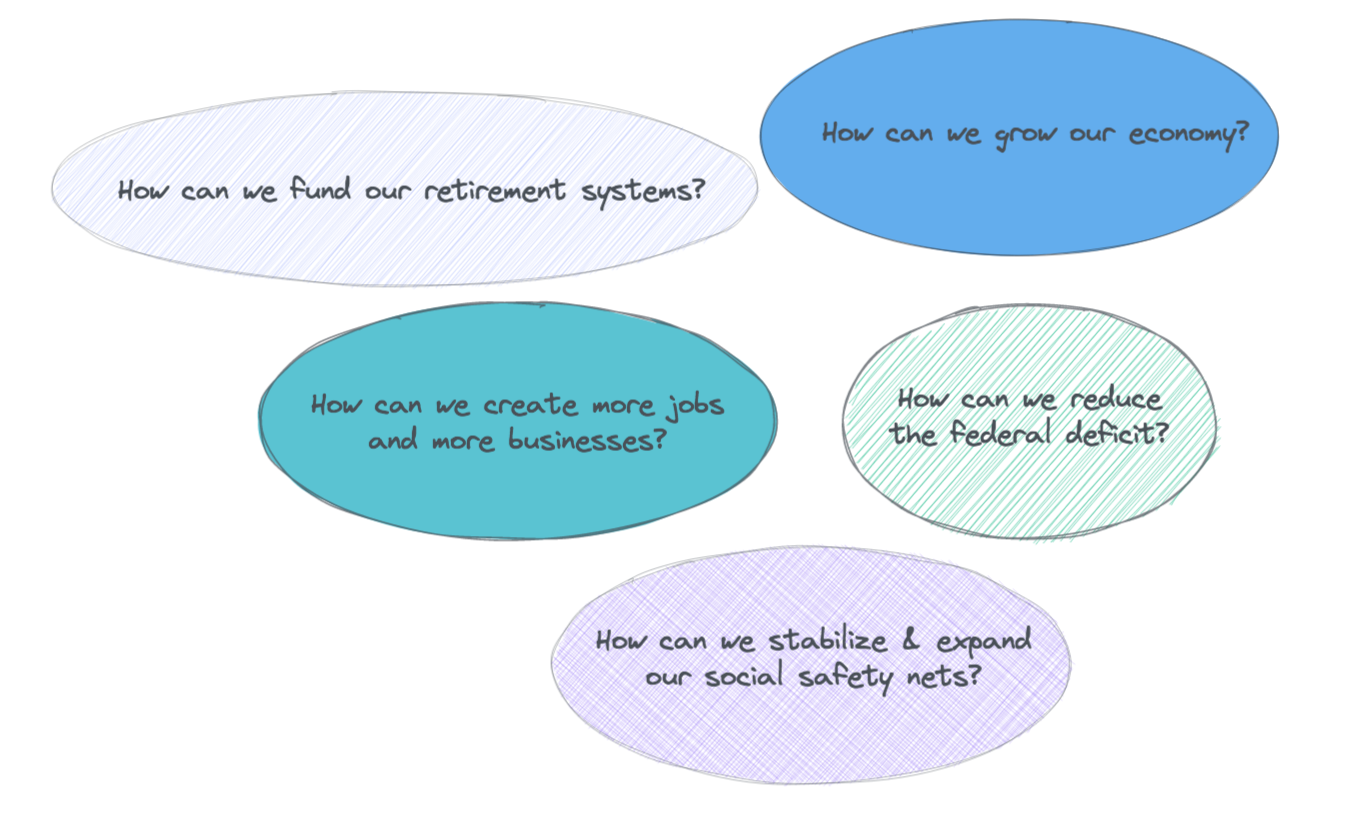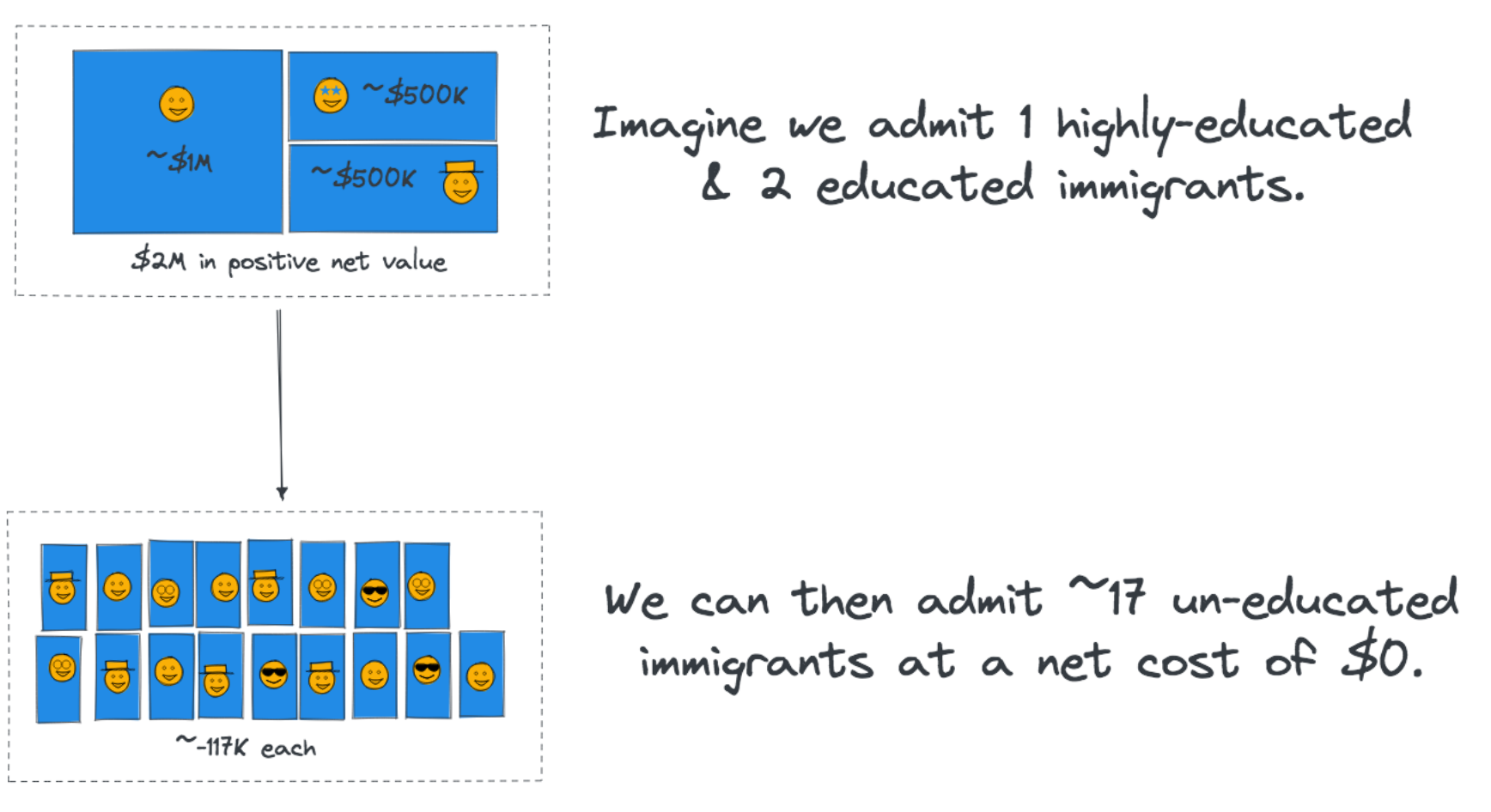That question should consume the thoughts of our brightest business leaders, government employees, politicians, and economists...yet we're often focused on different things. It is a big, broad question. Perhaps we'll gain clarity by breaking it down into a handful of more-specific questions:

- How can we fund our retirement systems?
- How can we grow our economy?
- How can we reduce the federal deficit?
- How can we stabilize & expand our social safety nets?
- How can we create more jobs and more businesses?
There’s one simple answer to all of these questions, and it’s quite obvious to those that have studied the problem - immigration. Not convinced? Let me explain.
Here’s the high-level plan: We should be a “brain magnet” for the best and brightest immigrants. Those immigrants will immediately start contributing dollars to our retirement systems, local infrastructure, social services, and local economies.
Much of the thinking here comes from a chapter in Joel Greenblatt’s book, “Common Sense” (paid link). This post is essentially my notes on chapter 4 of the book. I'm from the United States, so I'm writing from that perspective, but a lot of this thinking could be applied to any country - some other countries have already.
Greenblatt makes a great argument that this is free money sitting on the table, waiting to be taken. You’re probably wondering, like I did, how this could be possible. Does the math check out? How many of these “highly educated” immigrants are out there? And how many would actually come to the US? Wouldn’t they cause harm to working Americans and our middle class? Wouldn't they steal our jobs? Let’s dive into the details a little and see if it checks out...
Do people still want to migrate to the US?
Yes. A Gallup survey shows 147 million potential immigrants would choose the US to move to now, if they could. That’s 4x the next highest choice, Germany. So why aren’t we taking advantage? Here are a couple of the regulatory barriers:
- Only 7% of current green cards are issued based on employment qualifications. Most are issued based on family relationships.
- H1-B visas are another way to encourage skilled immigration, but it’s currently very expensive & inefficient...not to mention it has big limits....applicants have exceeded the allowed cap by 3x within 5 days of being open the last few years.
- Worse, if a company does find a good H1-B hire, it has to start the process in April. Even if they find a good candidate in May, they have to wait until the following April for the applicant to apply again, then wait 3-6 months after that for approval. Most companies can’t wait over a year to hire.
- H1-Bs are only good for 3 years, then they have to apply to extend for another 3 years, then apply for a green card after that.
- Costs to the company can add up to ~$50k per employee!?!?!
What do the numbers say?
NASEM (Natl Academy of Sciences Engineering and Medicine) says that on average, every highly-educated* immigrant settling in the US contributes ~$1M to the rest of us, right now (in today’s dollars).
*Highly educated = those with more than a bachelor’s degree, aged 25-64)
That $1M is the value in today’s dollars of all the future tax contributions* they (and their descendants) will make. That number is “net”, after subtracting the cost of government services they’ll use!
*accounts for the discounted value of future dollars, of course
Madeline Zavodny says that for every 100 skilled foreign-born workers allowed to work in the US, 183 additional jobs are created for American workers. Immigrants don’t steal jobs, they create them! (Well, at least we know skilled immigrants do. More on that later)
The NFAP (Natl Foundation for American Policy) says “immigrants have been key founders of 51 percent of US startup companies worth $1B or more.”
...and that “immigrants are twice as likely to start a business as native-born citizens.”
also, Duke research says “~25% of US tech companies have at least one immigrant as a founder.”
“Skilled immigrants are truly a natural resource, with the potential to yield an almost endless stream of money, growth, and jobs for the rest of us.”
Wait. Aren't we already admitting too many immigrants?
Business Roundtable says the "US ranked 2nd to last among developed countries in terms of welcoming skilled immigrants and entrepreneurs." How bad is that? Consider this: We almost lost to the last-place country, Japan - a country that basically requires you to be fluent in Japan to work there, is monoculture in many ways, and immigration is actively discouraged. We should all be embarrassed by this comparison.
Politicians claim the current system exists to “protect US workers from having their jobs stolen," but that’s a lie. Every claim is false. But wait, because of the messiness of work visas, companies are incentivized to hire US citizens, right? Not really. Let's look at it another way by answering a few common questions:
- Do jobs taken by skilled immigrants reduce avail jobs for domestic workers? No.
- Does the extra worker supply reduce pay for existing workers? No.
- Is this even a zero-sum game? No.
Still Not Convinced? Here are some more details on Joel's proposal
- Keep an employer-based system.
- Set a minimum salary, say ~$60k in 2018 dollars: if an employer will pay at least that much + a 20% tax on top of that to the government, then they can hire the foreign worker.
- After 5 years of completed employment, the worker can get a green card (no more 20% tax from that point on). Plus the employee is now on the path to citizenship. So they both win.
- LCA laws stay in place to assure pay is kept at or above the same level.
- No limit on the number of skilled workers admitted under this program.
- Adjust minimum salary by inflation each year.
What about unskilled workers? Shouldn't we be allowing them to migrate as well?
- NASEM says - immigrants without high school diplomas cost us ~$117k. (Again, “net” adjusted for the current value of those dollars in the future). So they’re using more govt services over their lifetimes (plus descendants) than they are adding to the system, by $117k in today's $$$. On average.
- Another cost factor: Center for Immigration Studies says - it is 12x more expensive to re-settle a refugee in the US than it is in the safest neighboring country, on average. (Given this, we might consider providing aid to help them settle elsewhere).
What if we let in more unskilled laborers into the country at a ratio that makes sense with the increases in skilled labor? Each skilled laborer is adding around $1M, so we could admit 4 unskilled workers and still have a huge surplus in value, not to mention the 3-4 new jobs created for US workers as well. This would allow us to do humanitarian work plus create growth opportunities for our country!

A Micro Experiment
An interesting way to approach this opportunity is to look at micro-experiments that have been conducted in small towns - Utica, New York provides an interesting one. Here's a great article from Jules Struck that details how refugees have saved Utica. I'll draw your attention to just one quote on the economic effects of refugees, please give the article a read for more info:
“When refugee families first land in the U.S., they cost taxpayers in public education, Medicaid, and temporary assistance, according to a 2000 study on the impacts of refugees in Utica and Oneida County by Hamilton College economics professor Paul Hagstrom. But after seven years, they start contributing to the economy. After 13 years, they contribute enough to make up those initial costs."
Conclusion
Increasing the admittance of refugees and unskilled immigrants isn't the only thing we could do with that money. The possibilities are endless, but we need to first tap into the money & opportunities we’re leaving on the table! Here are a few examples of what we could do with that money:
- Lift US children out of poverty. Permanently.
- Fund mental health programs.
- Improve & build infrastructure. Nationally and locally.
- Fund higher education.
- Lower income taxes (You may laugh, but we'd have room in the budget!)
...what else can you think of? Email me or find me on Twitter to let me know!
“Maybe we should seriously consider accepting all the money, jobs, and economic growth that will come with a new policy encouraging skilled immigration”
Final thought
The rest of the book contains unique insights on other topics like education, technology, investing, and social security. I highly recommend checking it out if you've enjoyed this post (paid link).


